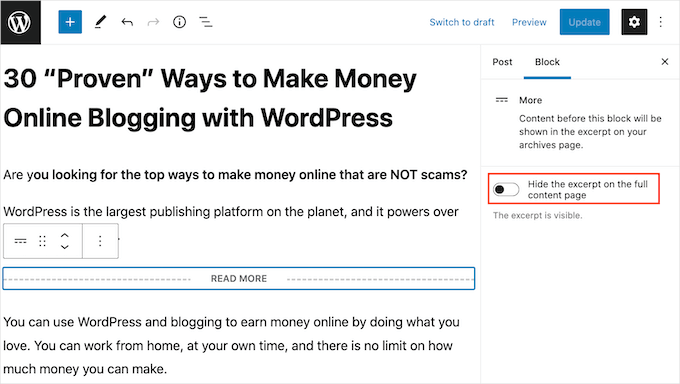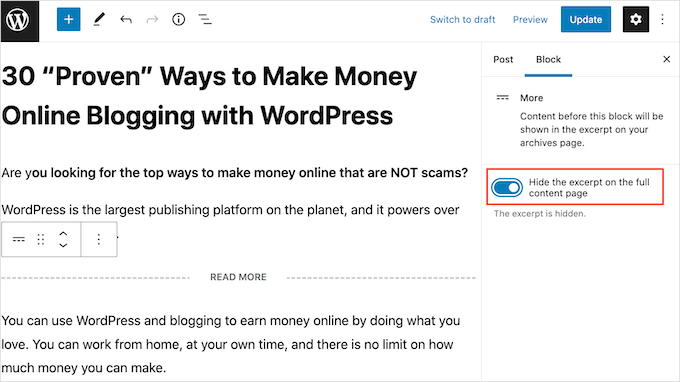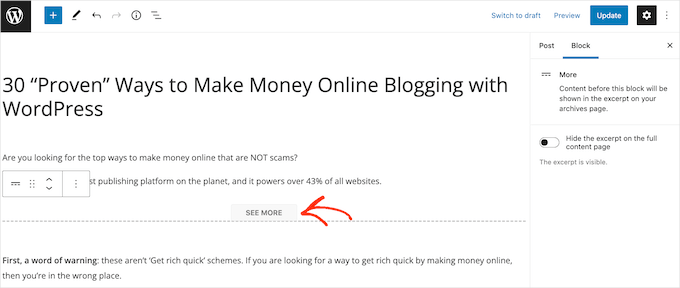Hướng Dẫn A-Z, Kiến Thức Wordpress
How to Properly Use the More Block in WordPress
How to Properly Use the More Block in WordPress
Using the More block in WordPress can help you create engaging previews of your posts. This feature grabs visitors’ attention and encourages them to read the full article.
For example, at WPBeginner, we use the ‘Read More’ link to direct readers to the complete blog post.
The good news is that WordPress offers multiple ways to show post previews on your archive and homepage, enabling you to do the same!
In this article, we’ll walk you through the steps to use WordPress’s More block. We’ll also cover creating an excerpt if your theme doesn’t support the More block.


When to Use the More Block in WordPress
Many websites use post previews to encourage visitors to check out the full version.
As a WordPress user, you can create post previews in a few different ways. For example, you might use a WordPress accordion plugin or show and hide content using the toggle effect.
By default, most modern WordPress themes automatically show a preview of your posts on the homepage and blog archives instead of the full post.
For example, our blog page shows a few words from the post and a ‘Read More’ link to the full post.


This preview text helps visitors see more of your blog’s topics without having to scroll through every post. It also helps increase pageviews since visitors will need to click through to finish reading a post.
You can control exactly what WordPress shows in these previews by using either the More block or an excerpt.
The best choice for your site will vary depending on your WordPress theme. Some themes will ignore any More blocks you create, so you’ll need to use an excerpt instead.
To help you show an engaging preview no matter what theme you’re using, we’ll cover both More blocks and excerpts. If you prefer to jump straight to a particular method, then you can use the links below:
- How to Properly Use the More Block in WordPress
- How to Change the More Block’s ‘Read More’ Text
- How to Properly Use Excerpts in WordPress
Ready? Let’s get started.
How to Properly Use the More Block in WordPress
The WordPress block editor has a built-in More block that allows you to specify the exact cutoff point for the preview text of any WordPress post.
In the classic editor, this block was previously known as the More tag.
You can add the More block anywhere in the post, including mid-sentence or in the middle of a paragraph.
All of the content above the More block will appear on your blog archive pages and wherever else your posts are listed on your WordPress site. WordPress will also add a ‘Read More’ link to the preview, so visitors can click to read the full version of the post.


Note: Every WordPress theme is different, and some may override the default ‘Read More’ label. With that in mind, you may see different text on your ‘Read More’ button.
Before you add a More block to your post, it’s important to check that your site is set up to show the latest posts on the homepage.
If you are using a static page as your custom homepage, then your theme may ignore the More blocks and use its own settings instead.
Not sure if you’re using a static front page as your homepage? You can check it by simply going to Settings » Reading in the WordPress dashboard.


At the top of this screen, you’ll see a ‘Your homepage displays’ section. If ‘Your latest posts’ is selected, then you should have no problems using the More block.
To get started, simply open the post where you want to add a More block. Then, find the spot where you want to create the cutoff point for your preview, and click on the ‘+’ icon to add a new block.
You can then type in ‘More’ and select the right block to add it to your page.


Some themes have a limit on how many words they will show on their homepage and archive pages.
If you include a large number of words in your preview, your theme may override the More block. So, it’s a good idea to create the cutoff point early in the post.
You can now carry on writing the rest of your post as normal.
You’ll be able to see the More block when editing your post in the block editor, but your visitors won’t see it when they’re reading the post on your WordPress blog.
Just like any other block, WordPress has some settings that you can use to configure the More block. To see these settings, simply click to select your More block.
In the right-hand menu, you can now choose whether to hide or show the excerpt on the full content page, which is the page you’re currently looking at.
By default, all of the content above the More block will appear on the full content page, as you can see in the following image:


However, you may want to write a custom excerpt that will appear only on your homepage and archive page and not in the full post itself.
To do this, simply click the ‘Hide the excerpt….’ slider to turn it from white to blue.


Now, everything above the More block will appear on the archive page and homepage only.
Once you’re finished, you can go ahead and save your changes by clicking on the ‘Update’ or ‘Publish’ button.
Now if you visit your homepage or blog archive page, you’ll see the preview you just created for this post.
Are you seeing something different?
Then your WordPress theme may be ignoring your More blocks.
Some themes are designed to show excerpts and will override all of your More blocks. If your homepage and blog archives aren’t showing the preview you created using the More block, then you may need to use excerpts instead.
How to Change the More Block’s ‘Read More’ Text
By default, the More block will show a Read More link on your archive and homepage.
There are several ways to change this text, but depending on your WordPress theme, you may get slightly different results. Some themes will override your changes with their own default settings.
To start, it’s worth checking whether you can change the Read More text using the WordPress post editor.
To do this, simply open any post that has a More block. You can then click on the default ‘READ MORE’ text and type in the text that you want to use instead.


After that, either update or publish the page as normal. You can then visit your homepage or blog archive to see whether the Read More text has changed.
If you’re still seeing the original Read More link, then you may need to override your theme’s settings using code.
You can either create a site-specific plugin or use a code snippets plugin like WPCode (recommended) to add the following code to your site:
|
1 2 3 4 |
function modify_read_more_link() { return '<a class="more-link" href="' . get_permalink() . '">Check out the full post</a>'; } add_filter( 'the_content_more_link', 'modify_read_more_link', 999 ); |
This replaces the default ‘Read More’ text with ‘Check out the full post,’ as you can see in the following image.
You can use any text you want by replacing ‘Check out the full post’ in the code snippet.


How to Properly Use Excerpts in WordPress
WordPress has two different ways to show a post preview. We’ve already covered the More block, but you can also create a preview using excerpts.
For visitors to your WordPress blog or website, previews are created using excerpts, and the More block looks exactly the same. However, some themes are coded to use excerpts, which means they will ignore your More blocks and show an excerpt instead.
If you don’t add an excerpt to a post manually, then WordPress will create one automatically based on the excerpt length defined by your theme. This can lead to previews that cut off mid-sentence.
With that in mind, you can choose to create an excerpt manually instead. To do this, simply open a post and then click to expand the ‘Excerpt’ section in the right-hand menu.


In the ‘Write an excerpt’ box, you can then either type in or paste the excerpt that you want to use for the post.
Don’t see an ‘Excerpt’ box in the right-hand menu? Then you can enable this setting by clicking on the three-dotted icon in the upper-right corner.
Once you’ve done that, let’s click on ‘Preferences.’


In the popup that appears, simply click on ‘Panels.’
You’ll now see all the settings that you can add to the right-hand menu. Simply find ‘Excerpt’ and give it a click to turn it from white (disabled) to blue (enabled).


Then, simply close this popup. You should now have access to the ‘Excerpt’ settings in your right-hand menu.
Now, you can create an excerpt following the same process described above.
Once you’ve done that, simply save your changes and visit your site. You will now see your custom excerpt on the homepage and blog archive.
We hope this article helped you learn how to use the More tag in WordPress properly. You may also want to check out our guide on how to add multi-column content in WordPress posts or how to add tables in WordPress posts and pages with no HTML required.
If you liked this article, then please subscribe to our YouTube Channel for WordPress video tutorials. You can also find us on Twitter and Facebook.

